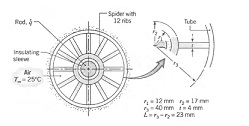Solve the following:
Q: A long rod of 20-mm diameter and a thermal conductivity of 1.5 W/m · K has a uniform internal volumetric thermal energy generation of 10 6 W/m3. The rod is covered with an electrically insulating sleeve of 2-mm thickness and thermal conductivity of 0.5 W/m · K. A spider with 12 ribs and dimensions as shown in the sketch has a thermal conductivity of 175 W/m. K, and is used to support the rod and to maintain concentricity with an 80-mm-diameter tube. Air at Tx = 25°C passes over the spider surface, and the convection coefficient is 20 W/m2 · K. The outer surface of the tube is well insulated. We wish to increase volumetric heating within the rod, while not allowing its centerline temperature to exceed 100°C. Determine the impact of the following changes, which may be effected independently or concurrently:
(i) increase the air speed and hence the convection coefficient;
(ii) changing the number and/or thickness of the ribs; and
(iii) using an electrically non-conducting sleeve material of larger thermal conductivity (e.g., amorphous carbon or quartz). Recommend a realistic configuration that yields a significant increase in q.
